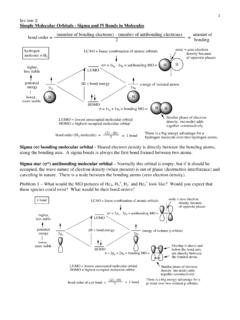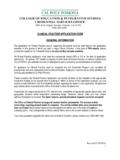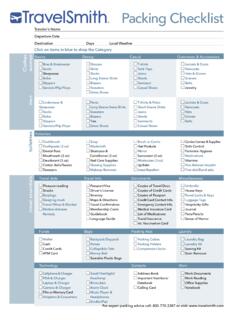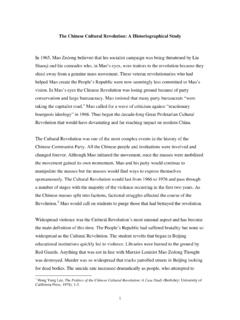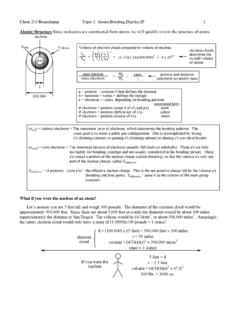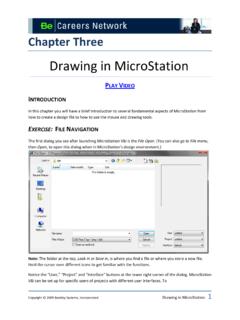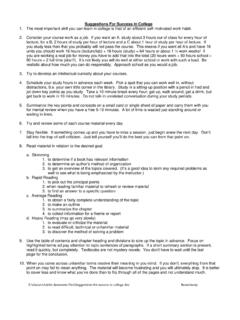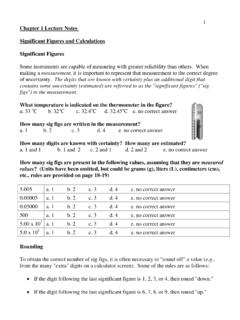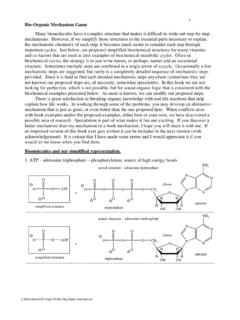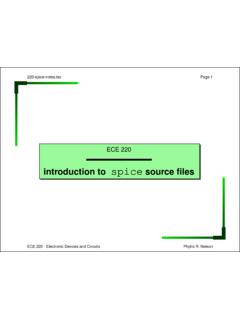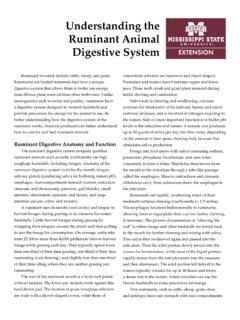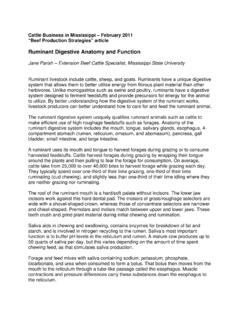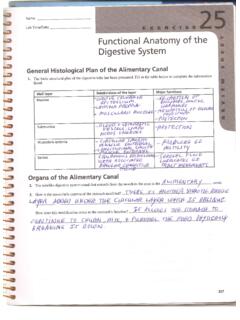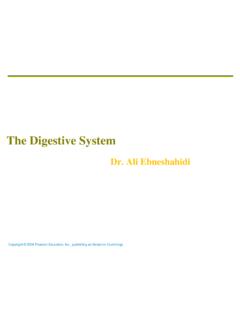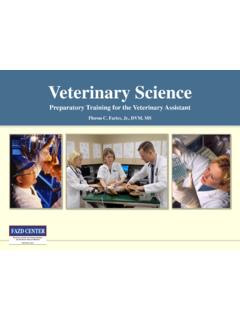Transcription of Digestive Tract Comparison - CPP
1 Digestive Tract Comparison Human/Dog Digestive system or Simple Monogastric Digestion Small Intestine The small intestine is a tube roughly twenty feet long deided into the duodenum, jejunum and ileum. The first part of the small intestine is the duodenum, the site of most chemical Digestive reactions and is Mouth smoother than the rest of the small intestine A specialized region of the Digestive Tract designed to break up large particles of food into Bile, bicarbonate and pancreatic enzymes are secreted into the duodenum to breakdown nutrients in the smaller, more manageable particles chyme so that they can be readily absorbed. Saliva is added to moisten food and begin carbohydrate breakdown by amylase in humans. Bicarbonate from the pancreas neutralizes corrosive stomach acid from in the stomach to in the There are four main types of teeth in the human or dog: incisors, canines, premolars and small intestine.
2 Molars. Pancreatic enzymes include lipases, peptidases and amylases. One reason dog and cat canines are much larger than ours is that they need to be able to rip and Lipases break down fats. Peptidases break down proteins. Amylases break down carbohydrates. tear through tough raw meat. Humans have evolved to eat easier to chew, cooked meat. Bile from the liver is stored in the gall bladder and secreted into the duodenum to emulsify fat. While chewing, food is transformed into what is called a bolus, a food ball, and then forced The jejunum and ileum are next in the small intestine and are covered in villi, finger-like projections. down the throat by the tongue. Each individual villi is covered in microvilli that greatly expand the surface area of the small intestine to maximizes the ability to absorb nutrients. Pharynx Most absorption in the simple monogastric Digestive system happens in the jejunum.
3 The pharynx is the shared tube of the respiratory and Digestive tracts. Fats are passed into the lymphatic system . Glucose, amino acids and other nutrients are absorbed into the It houses the epiglottis, a flap that closes off the tracheal opening while swallowing so food blood stream does not enter the respiratory Tract while swallowing. Large Intestine Esophagus The ileocecal valve opens into a length of Digestive Tract composed of the cecum, colon and rectum. An thick and muscular organ of transport. The cecum is a blind sac at the end of the large intestine. Contracts rhythmically to transfer the bolus from the mouth and pharynx to the stomach A finger shaped appendix with no functional role today, extents from the cecum. through peristalsis The colon is the site of bacterial fermentation. The rectum is the tube extending from the colon. Stomach Fecal matter that has had all the water removed is now called feces and is stored in the rectum till it can be The bolus enters the stomach by passing through a valve-like cardiac sphincter.
4 Eliminated via the anus. The stomach is highly elastic, able to stretch to many times its original empty volume in order The large intestine is filled with a huge amount of bacteria that ferment undigested carbohydrate. to hold great volumes of digesting food. For example, a one hundred fifty pound human would have fifteen pounds of bacteria in their gut. Sphincters let controlled amounts of food in and out of the stomach and help to contain the These bacteria are essential to the health of the animal. corrosive compounds in the stomach. By fermenting undigested carbohydrate these bacteria create products that can be used by the animal for The stomach is protected from its own acids by mucus secreted by cells in the stomach lining. energy. Stomach muscles churn the bolus and mix it with gastric juices to form a liquid that is now Methane and other unusable gaseous products made by the bacteria are released as flatus.
5 Called chyme and is into the small intestines. Water and salt reabsorption also occurs in the large intestine. Human Digestive Tract Protein digestion by pepsin begins in the stomach. Cat Digestive system or Obligatory Carnivore Digestion Small Intestine Kidney The small intestine in the cat is notably shorter than the small intestine of other species. Mouth Large As an obligatory carnivore means that the cat is taking in very highly digestible foods. Rectum As an obligatory carnivore is an animal that must eat meat and bone material to survive. Intestine Since the food it eats does not take much time to break down the cat can afford to have a Pancreas The cat has the same four types of teeth that the omnivore has but its teeth are all pointed shorter Digestive Tract . Esophagus Liver for puncturing and gripping. This conserves energy and conveys an evolutionary advantage to the cat making it lighter and The canine teeth are designed for puncturing, holding and tearing food and are much larger better able to catch prey.
6 Proportionally than even the primarily carnivorous dog. Anus Additionally, the last upper premolars and first lower molars are modified into specialized Liver and Gall Bladder carnassials that provide slashing and cutting ability to the animal. Their tongue is also specialized for use by the obligatory carnivore. Bladder The meat that cats survive on is not only high in protein but also fat. It is covered in fine hook like projections that allow the cat to more easily scrape fine tissue A working liver and gall bladder to supply bile are essential to cat digestion. from bone to get as much from a meal as it can. The low carbohydrate consumption by the cat means little glucose is available for absorption Mouth via the Digestive Tract . Stomach Stomach Small Glucose production via Gluconeogenesis in the liver and is important for obtaining the The cat's stomach is a sac-like organ with all the characteristics of the omnivore's stomach Intestine absolute requirement for glucose Enzymatic digestion of protein is started in the stomach.
7 Gluconeogenesis is the breakdown of amino acids from protein to form glucose. Cat Digestive Tract Rectum Large Intestine Cow Digestive system or Foregut Fermenter Digestion Reticulum Small Intestine The reticulum is rough and honeycomb-like. Omasum Mouth The reticulum is a smaller pouch that acts as a sort of trap for large objects leaving the The cow has thirty-two teeth, eight incisors and twenty-four molars and premolars rumen. Anus The top jaw has no teeth in the front but instead has a hard pad of skin for the bottom incisors to clamp against. They essentially have a built in filter to allow them to take in huge amounts of low When a cow is grazing it is actually just ripping up sections of plant material, chewing a few times to mix them with digestibility feed very fast and ferment it into useable energy while not taking in dangerous Esophagus saliva, and then swallowing the bolus whole.
8 Objects in their haste. Esophagus Omasum Unlike the simple monogastric, the cow's esophagus can bring food from the pharynx to the stomach and also easily After the food material has been sufficiently broken down go through the rumenoreticulo-omasal work in the other direction, bringing material from the stomach to the mouth for remastication. orifice and into the omasum. This process is called antiperistalsis. The omasum is a highly folded organ that holds about two and a half gallons of material. It has small projections on its surface that allow it to act as a sort of sieve. Stomach It allows water and minerals such as sodium and phosphorus to be reabsorbed from the food The cow's stomach resembles one stomach split into four separate compartments each of which has a separate It also acts as a pump from the reticulum to the abomasum for the solid portion of foods. function.
9 Only one compartment carries out the roles associated with the monogastric stomach. Abomasum Reticulorumen Once food is pumped into this stomach compartment from the omasum, the acid digestion that The reticulorumen is comprised of two sacs, the reticulum and rumen. we traditionally think of as happening in the stomach begins. Rumen Reticulum The two compartments are closely associated and are separated by a reticular fold. Ruminants almost always have something coming into their abomasum. Abomasum Rumen They differ from monogastrics who tend to only eat and release food into their stomachs in a Mouth The rumen is muscular and covered in papillae, the finger-like projections. rhythm at different times throughout the day. When ruminants like the cow are not grazing they are likely resting and chewing their cud'. Cud chewing is Chyme is, therefor, created and deposited into the small intestine throughout the day.
10 Where food is returned to the mouth for continuous rechewing and addition of more saliva. Muscle contractions mix a dense microorganism slurry composed of symbiotic bacteria, protozoa and fungi. Small Intestine These microorganisms work to break down the animal's food and release nutrients via fermentation. The small intestine in the cow is proportionally longer. Through the papillae, products of microbial fermentation (volatile fatty acids) are absorbed directly into the The cow needs more area so that it has more time to absorb nutrients from the food it is blood stream. digesting. In essence the rumen is one giant fermentation vat that can hold up to fifty gallons of partially digested material. The micro flora growing in the rumen are a source of protein for the cow. The bacteria eat' the grass and the Liver and Gall Bladder cow eats' the bacteria. This allows the cow to eat grass and turn it into a viable source of energy.
